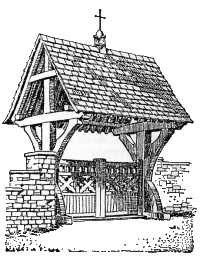Twenty years ago when we moved in we replaced the decayed front gate. Twenty years on, that one too has succumbed to the weather - and the original posts have rotted too.
Seemed like an opportunity to do a bit more, to 'celebrate the necessary', and in line with recent reflections on physiognomy, to make the house-mouth speak with a more confidence and enthusiasm.
A roofed gate on the boundary marks and celebrates the threshold between two kinds of space, whether public and private, the town and the countryside or even between profane and sacred - as in the Japanese Tori Gate and countless Asian examples.

The roof is a foretaste of the shelter to be provided, whether in the traditional church lychgate, or the 1929 example of Le Corbusier's Salvation Army hostel, where the two storey porch is the start of a wonderfully choreographed route to a place of refuge.


Our new gate is made of green oak, with the 75mm posts set in 600mm deep 150mm dia holes, backfilled with an angular sub-base gravel to both drain and bind. Rot normally seems to occur at the ground to air margin, so I've tried a experiment of charring a 400mm section around the ground line with a blow torch. These black gaiters look rather good marking the base of the posts.
 |
The gate frame itself is made of 12 year old seasoned oak, recycled from an earlier project - a case study for resource efficient re-use of timber in construction, something we plan to explore more this year.


A composition of dancing curves, adding a bit of delight to the streetscape.


No comments:
Post a Comment